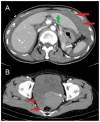Traditional Chinese Acupuncture Causing Acute Hemoperitoneum from Direct Liver Injury
- PMID: 37654899
- PMCID: PMC10435255
- DOI: 10.3941/jrcr.v17i8.5100
Traditional Chinese Acupuncture Causing Acute Hemoperitoneum from Direct Liver Injury
Abstract
Traditional Chinese medicine is a popular form of complementary and/or alternative medicine in Southeast Asia, often incorporating acupuncture. Acupuncture involves the insertion of thin needles into varied anatomical points on the body for the relief of a range of symptoms, such as musculoskeletal aches and pains. We present the first reported case of percutaneous liver injury secondary to acupuncture. We aim to familiarize readers with this rare and as-yet unreported case of intra-abdominal injury related to acupuncture, which is commonly practiced in many countries in Eastern and Southeast Asia.
Keywords: Hepatic injury; acupuncture; complementary and alternative medicine; complications; hemoperitoneum; hepatic hemorrhage; surgery; traditional Chinese medicine.
Copyright Journal of Radiology Case Reports.
Figures




References
-
- Peltzer K, Pengpid S. Utilization and Practice of Traditional/Complementary/Alternative Medicine (T/CAM) in Southeast Asian Nations (ASEAN) Member States. Studies on Ethno-Medicine. 9(2):209–218. doi: 10.1080/09735070.2015.11905437. - DOI
-
- Lao L, Hamilton GR, Fu J, et al. Is acupuncture safe: a systematic review of case reports. Database of Abstracts of Reviews of Effects (DARE): Quality-assessed Reviews [Internet] York (UK): Centre for Reviews and Dissemination (UK); 2003. p. 1995. - PubMed
-
- Ullah W, Ahmad A, Mukhtar M, Virk HUH, Sarwar U, Figueredo V. Acupuncture-Related Cardiac Complications: A Systematic Review. J Invasive Cardiol. 2019 Apr;31(4):E69–E72. - PubMed
-
- Gomez E, Horton K, Fishman EK, et al. CT of acute abdominopelvic hemorrhage: protocols, pearls, and pitfalls. Abdom Radiol. 47(2022):475–484. - PubMed
Publication types
MeSH terms
LinkOut - more resources
Full Text Sources
Medical

